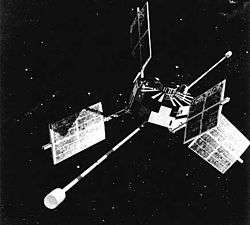Explorer 34
Explorer 34, also called IMP-4 and Interplanetary Monitoring Platform IMP-F, was an American satellite launched as part of Explorers program. Explorer 34 as launched on 24 May 1967 on Vandenberg Air Force Base, California, United States, with Delta rocket. Explorer 34 was the fourth satellite of the Interplanetary Monitoring Platform.[5]
 Image of the satellite Explorer 34. | |||||||||||||||||||||||||
| Mission type | Space research | ||||||||||||||||||||||||
|---|---|---|---|---|---|---|---|---|---|---|---|---|---|---|---|---|---|---|---|---|---|---|---|---|---|
| Operator | NASA | ||||||||||||||||||||||||
| COSPAR ID | 1967-051A[1] | ||||||||||||||||||||||||
| SATCAT no. | 2817 | ||||||||||||||||||||||||
| Spacecraft properties | |||||||||||||||||||||||||
| Launch mass | 163 kg (359 lb) | ||||||||||||||||||||||||
| Start of mission | |||||||||||||||||||||||||
| Launch date | 24 May 1967, 14:05:54 UTC[2] | ||||||||||||||||||||||||
| Rocket | Delta E 486/D49 | ||||||||||||||||||||||||
| Launch site | Vandenberg SLC-2E[3] | ||||||||||||||||||||||||
| End of mission | |||||||||||||||||||||||||
| Decay date | May 3, 1969[4] | ||||||||||||||||||||||||
| Orbital parameters | |||||||||||||||||||||||||
| Reference system | Geocentric | ||||||||||||||||||||||||
| Regime | Highly Elliptical | ||||||||||||||||||||||||
| Eccentricity | 0.92489[1] | ||||||||||||||||||||||||
| Perigee altitude | 2,031 km (1,262 mi)[1] | ||||||||||||||||||||||||
| Apogee altitude | 209,242 km (130,017 mi)[1] | ||||||||||||||||||||||||
| Inclination | 68.5°[1] | ||||||||||||||||||||||||
| Period | 6,218.3 minutes[1] | ||||||||||||||||||||||||
| Epoch | 24 May 1967[1] | ||||||||||||||||||||||||
| Instruments | |||||||||||||||||||||||||
| |||||||||||||||||||||||||
Explorers | |||||||||||||||||||||||||
Mission
Explorer 34 was placed into a high-inclination, highly eccentric earth orbit. The apogee point was located near the ecliptic plane and had an initial local time of about 1,900 hours. The spacecraft was spin-stabilized and had an initial spin period of 2.6 seconds. The spin vector was approximately perpendicular to the ecliptic plane. Like the earlier IMPs, this spacecraft was instrumented to study interplanetary magnetic fields, energetic particles, and plasma.
The spacecraft optical aspect system failed on 4 March 1969. Otherwise, useful data were acquired until just before spacecraft reentry, which occurred on 3 May 1969.[1]
See also
References
- "IMP-F". NSSDCA. NASA Goddard Space Flight Center. Retrieved 16 June 2018.

- "Launch Log". Jonathan's Space Page. Jonathan McDowell. Retrieved 16 June 2018.
- "IMP". Encyclopedia Astronautica. Mark Wade. Retrieved 16 June 2018.
- "EXPLORER 34". n2yo.com. Retrieved 16 June 2018.
- "Explorer 34/IMP-4". Spacecraft Encyclopedia. Claude Lafleur. Retrieved 16 June 2018.
.png)